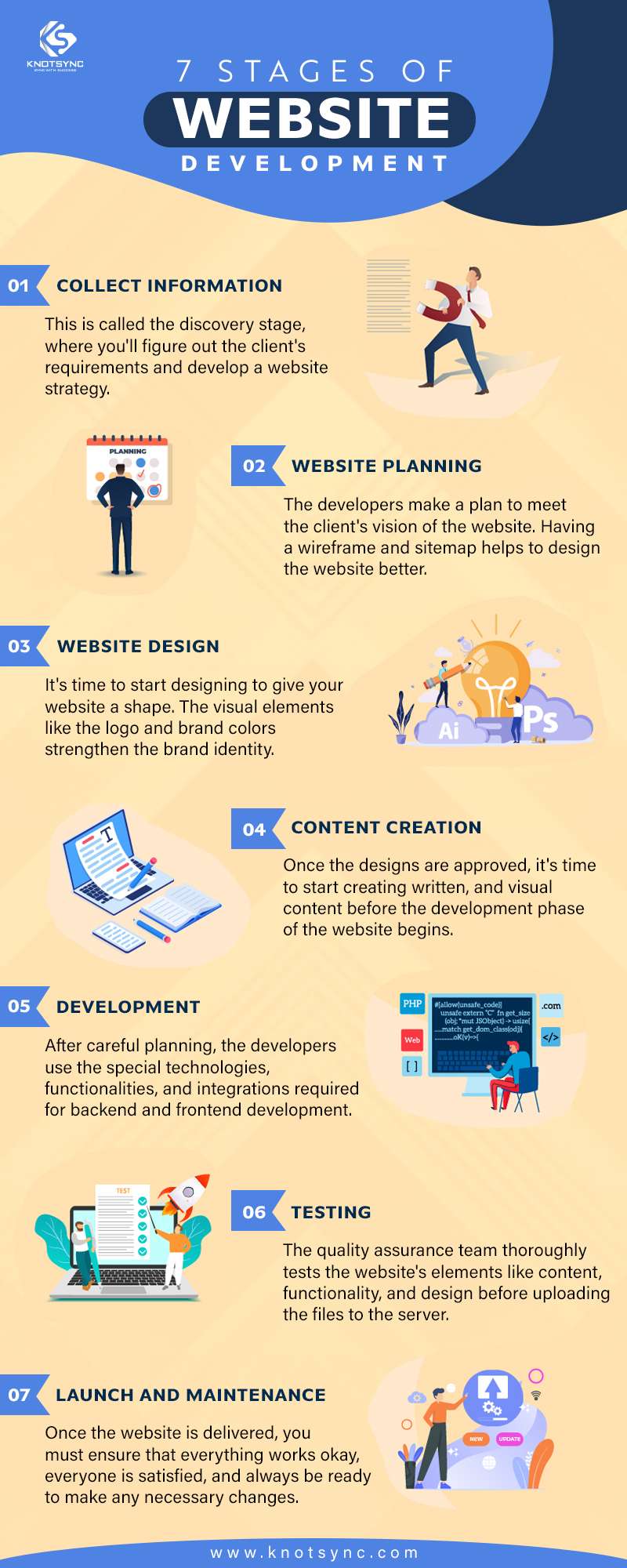Stages of Website Development
Clients find it valuable to learn the web development process we follow when working on their websites. It helps them plan and decide what they need to provide in terms of research, content, and budget. Also, it allows them to figure out the resources and time they need to allocate to their website development project. But, before jumping onto the Stages of Website Development, let’s know a bit about web development—
What is Website Development?
Web Development is the building and maintenance of websites. It includes all the work to build a website that looks excellent, works efficiently and effectively, performs well, and gives a seamless user experience. Web developers do this with the help of a variety of coding languages. But it does not begin and end with coding.
Let’s Have a Look at the 7 Stages of Website Development
All the stages of website development are equally important. In this article, we will talk about the entire process of developing a website. It starts with building a website plan to launching the website.

1. Collect Information
The first and most crucial step for website development is understanding the purpose. This is the discovery stage. This is where you’ll figure out the requirements and expectations of the client from the website.
Before you start working on the website, you should know the audience that the business wants to attract to its site and the content needed for them. These kinds of questions help you make a better strategy for your website. Once you have the answers to your questions, you can get onto the next step stage and plan the website creation.
2. Website Planning
Having a well-described and detailed plan before starting website development can help you save many resources like time and money.
“Every minute you spend in planning saves 10 minutes in execution; this gives you a 1,000 percent return on energy!” – Brian Trac.
So, after collecting all the necessary information, the developers can start planning the website. As a part of their planning for website development, the developers aim to meet their mission with the client’s vision of the website. If you plan and create a site map, you can build a website that will work great and get you closer to your business objectives.
Having a wireframe visually describes the site showing all the functions and features needed like login, email subscription, admin, live chat, etc. Once you have a concrete website plan, you should discuss and get approval from the client before you start to code or even work on any design. Once everything looks fine to them, you can get on to the next step of website development.
3. Website Design
It’s time to start designing and adding visual elements to give your website a shape. The visual elements like the logo and brand colors strengthen the brand identity.
Create the web design keeping the client and their interests in mind as it determines the success of your online business. The designers can create one or more prototypes for the website. Having clickable prototypes lets the client have a final look and feel of the website before it’s developed. The design layout is then reviewed by the customer, who sends you the feedback.
4. Content Creation
Once the landing page and other designs are approved, it’s time to start creating written and visual content for your landing page. You must have real content to work on before the development phase of the website begins.
Content that clearly communicates your business, service, and product enriches your website’s user experience. The content should be guided by keyword research and SEO rules. Search engines quickly pick up well-written, informative, and keyword-rich content, making the site easier to find.
5. Development
After careful planning, we reach the most important phase of the website development process. At this step, you can create the website itself. Usually, the first page is created, then all the sub-pages are added. Frameworks and CMS should be applied to ensure that the server can handle all the installations and set them up efficiently and effectively. The developers define the technologies, functionalities, and integrations required for backend and frontend development. Development occurs in two phases-
Frontend Development
Once the clients approve the designs for the website, it is then made into live digital experiences using unique animations and effects. The developers ensure they build a user-friendly website that’s responsive on all devices using HTML, CSS, and JavaScript.
Backend Development
The backend developers follow the high-quality standards and processes and use the selected technologies to create a backend code on Microsoft .NET and Node.js, that enables user-side and server-side interaction, interfacing the whole website.
It might not appear to the end-user, but the backend developers are responsible for creating high-performance and scalable websites, taking care of the technical SEO, security, and user experience.
6. Testing
After the Development phase, it’s time to test the website. The quality assurance team thoroughly tests the website’s elements, including speed to responsiveness and other design elements, integrations, security, etc. Testing is essential before the website goes live.
Test every link to ensure that there are no broken ones among them. You need to check every script and form and run a spelling check to find out any possible typing mistakes.
After testing the website for content, functionality, and design, upload the files to the server. Once you upload the files to the server, review and re-check your website. This ensures that the website is working right before the official launch.
7. Launch and Maintenance
Once the website is live, you must ensure that everything works okay, and everyone is satisfied. You should always be ready to make any necessary changes. The feedback option will tell you what problems users face and what you need to fix. Do not forget to keep updating your website from time to time.
It’s all about finding the right balance between structure and function. You need to use the correct elements like the right fonts, colors, and design motifs to let people navigate and experience your site to the best.
Hiring a Developer to Implement 7 Stages Of Website Development
To hire a developer to implement the 7 Stages of Website Development, begin by identifying the specific needs and objectives of the project. This involves clarifying the scope, technology stack, target audience, and functionality of the website. Understanding these parameters will guide you in finding a developer with expertise in the exact areas needed for your project.
When seeking a developer, carefully consider their portfolio, experience, and technical skills. Analyze their past work to gauge their proficiency in implementing the 7 stages of website development:
- Information Gathering
- Planning
- Design
- Content Writing and Assembly
- Coding
- Testing
- Review and Launch
- Maintenance
Assess their experience with various programming languages and tools that align with your project’s requirements.
Utilize professional networking platforms like LinkedIn, job boards, or specialized tech recruitment agencies to find suitable candidates. These resources can provide access to a wide talent pool, enabling you to find developers with varied experience levels and specialties.
Once you have shortlisted potential candidates, conduct comprehensive interviews to assess their understanding of the 7 stages and compatibility with your project’s requirements. Include technical assessments, situational questions, and potentially a small coding task to evaluate their practical skills. This is a great guide to get you started on hiring a web app developer.
During the interview and negotiation phase, discuss the project timeline, budget, and expectations clearly. Transparency about deadlines, costs, and the specific responsibilities of the developer will foster mutual understanding and collaboration.
Upon selection, create a well-defined contract outlining the responsibilities, deadlines, payment terms, and any other essential aspects such as intellectual property rights, confidentiality agreements, and termination clauses. Ensuring all terms are clearly defined in a formal contract will minimize misunderstandings and potential disputes, contributing to a successful collaboration.
Regular communication, ongoing feedback, and clear documentation can further enhance the relationship with the developer and ensure that the project progresses according to plan through the 7 Stages of Website Development. It’s essential to maintain a collaborative environment where both parties invest in achieving the project’s success. Still confused about it? Consult a website development company.




